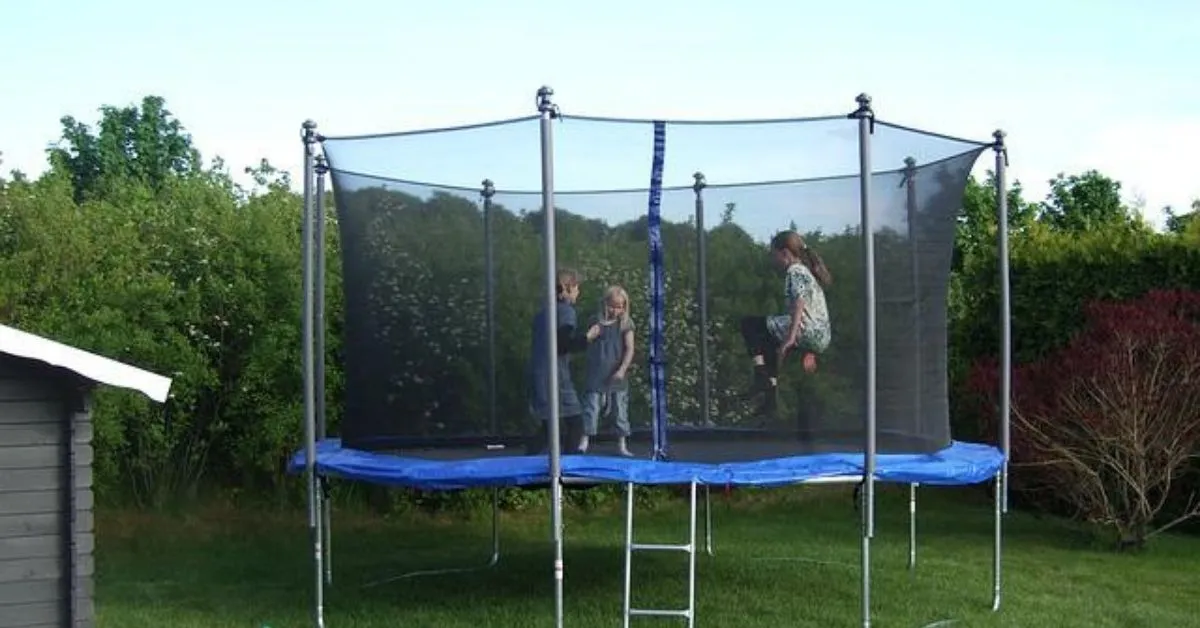Trampolines are a great way to get fit and have fun simultaneously. Buying a trampoline for a family is an excellent idea for your backyard, and it can be an exciting prospect for your children. Now you have to figure out how to install it on your own.
But the problem is that the ground is not flat and you need to install it on a slope. You need to know if you have the right tools, space and pitch. Also, you need to know how to assemble it correctly.
If you have ever wanted to Know How To install trampoline on slope or uneven ground, you might have faced problems with the safety net installation. This article will guide you on installing a trampoline on a slope.
In this blog, we have a guide on installing a trampoline when the ground is uneven or on a slope.
How Should the Area Around the Trampoline Look?
The area around your trampoline should be level and clear of any obstacles. It’s essential to install your trampoline on a firm, level surface to prevent injuries. The best way to achieve this is to create a level area around the trampoline. This can be done by clearing away any debris and making sure the ground is level.
It is best to install your trampoline on a level surface. This will help to ensure that the trampoline is stable and safe to use. If you are not able to install the trampoline on a level surface, you should make sure that the area around the trampoline is clear of any obstacles that could cause the trampoline to tip over.
Once you’ve created a safe, level area around the trampoline, you can install your trampoline and enjoy it for years to come!
Contents
Trampoline safety considerations when installing
When installing a trampoline, there are several safety considerations to keep in mind.
- First, the trampoline should be level. If it is not level, the jumpers could be thrown off balance and injured.
- Second, there should be no objects underneath the trampoline. This could cause the jumper to land on something hard and get hurt.
- Third, the slope around the trampoline should be gentle. If too steep, jumpers could fall off the trampoline and get injured.
- Finally, make sure you put your trampoline in a safe place. It should not be near trees, power lines, or other hazards.
By following these guidelines, you can help keep everyone safe while they enjoy their trampoline.
Can You Put a Trampoline On a Slight Slope?
I get a lot of questions about how to install a trampoline on a slope or uneven ground. A lot of people think that if their ground is sloped, they can’t get a trampoline, but this is not true! Trampolines can be installed on slopes and uneven ground.
To install a trampoline on a slope or uneven ground, you will need to pay attention to the safety instructions and recommendations given by the trampoline manufacturer. What you need to do is to adjust the ground level and shape of the surface where you will be installing your trampoline.
How Do You Level a Trampoline in a Sloped Yard?
In order to level a trampoline on a slope, you will need to install it in such a way that the entire surface is level. This can be achieved by using concrete footings or metal supports. If you have a large slope, you may need to level the trampoline in sections.
To measure the slope of a trampoline, you will need to find the level spot on the trampoline, and measure the distance from the top of the trampoline to the side. The slope is determined by the diameter of the trampoline and the height of the top of the trampoline.
Trampolines can be placed on a slight slope if you level the trampoline and use a levelling kit. Ensure your trampoline legs are on the higher side when you install the trampoline. This will ensure that your trampoline is level and stable on the slope.
Is it dangerous to put a trampoline in a sloped yard?
Trampolines can be installed on sloped yards, but there are some safety concerns to consider. The biggest problem is that the trampoline could tip over if someone jumps too hard or falls off to one side. If the trampoline is not installed correctly, it could slide down the slope. If you are considering installing a trampoline on a sloped yard, make sure to consult with a professional to ensure it is done safely.
Using Leveling Blocks/Kits
The best way to level a trampoline is to use the levelling blocks. You want the trampoline to be level so that it doesn’t slope towards the ground. If the trampoline is on uneven ground, you can move your trampoline until it’s level. If the legs of the trampoline are too long, you can cut them, so they’re the same length.
- A trampoline can be installed on a slope or uneven ground by using a levelling kit or levelling block to level the trampoline.
- To install the trampoline on a slope, first, dig a trench around the perimeter of the trampoline.
- Next, level the trampoline by installing a leveling kit or leveling block.
- Finally, install the trampoline by following the manufacturer’s instructions.
Using Trampoline’s Brackets:
When installing a trampoline, you need to make sure that the base is completely level. When installing a trampoline on a slope, the angle should not be steeper than 1:12, otherwise, the safety net and jumping mat will not be flush with the ground. The trampoline will also not be able to move in the right way and won’t provide the right bounce. The solution? Use the special trampoline bracket that allows you to install a trampoline on uneven ground. This is the only way that you can ensure your trampoline is safe and secure and it will provide the right bounce.
Best Tips to Install a Trampoline On a Slope?
Trampoline assembly on sloped, slanted, uneven or rough ground is a common problem that may be more difficult than on the flat basis. But there is no need to fret. Here are some tips that should help you:
-
- Lay the frame first the first thing you should do is set the frame first before anything else. The frame must be kept straight and stable. You can use a level or a straight board to ensure the frame is in a leveled position.
- Attach the legs Second, attach the legs. Attach the legs of the trampoline in the same manner as when you put it on a flat ground. If your trampoline is of the foldable variety, then it is best to attach the legs after you have placed the jumping mat.
- Add the mat or jumping surface.
But we all know that these ground surfaces can be challenging to install a trampoline on.
So you should decide if you want to install it yourself or find a professional. If you’re going to install it yourself, you should search for a trampoline specifically made to be installed on some degree of uneven ground.
We recommend the Skywalker 7′ trampoline because it’s specifically built to be installed on uneven ground. But if you don’t want to go through the hassle of installing it yourself, you should look for a company that installs trampolines on uneven ground.
What do you use to level a trampoline?
To level a trampoline, you will need to use something that is level itself. This could be a spirit level, a laser level, or even a good old-fashioned ruler. Place the level on the trampoline frame and make sure that it is level from front to back and side to side. If it is not level, then you will need to adjust the legs of the trampoline until it is.
Can wind pick up a trampoline?
Can wind pick up a trampoline? It is possible for solid winds to lift a trampoline off the ground, but it would take a mighty gust to do so. If you have a trampoline storming outside and you’re concerned about your trampoline being blown away in high winds, you can do a few different things with it.
- One option is to take the trampoline down so it doesn’t blow away or damage.
- Another option is to leave the trampoline and not use it until the storm passes.
- And finally, You can anchor it down with weights or tie it to something sturdy.
Cut Trampoline Legs to Level
If your trampoline isn’t level, you can cut the legs to make it level. You’ll need a saw and someone to help you hold the trampoline while cutting. Measure the height of the trampoline from the ground to the jumping surface. Then measure the distance from the ground to where you want to cut each leg. Cut each leg at the appropriate height so that when all four legs are cut, the trampoline is level.
Final Words
This was all about installing a trampoline on uneven ground. We hope this blog post has helped you learn how to install your own trampoline on an uneven surface!

